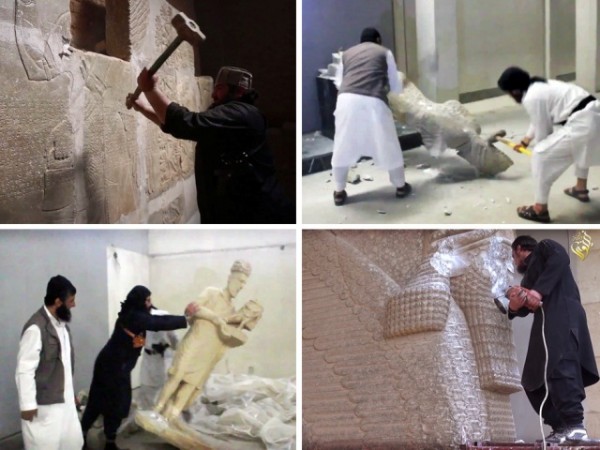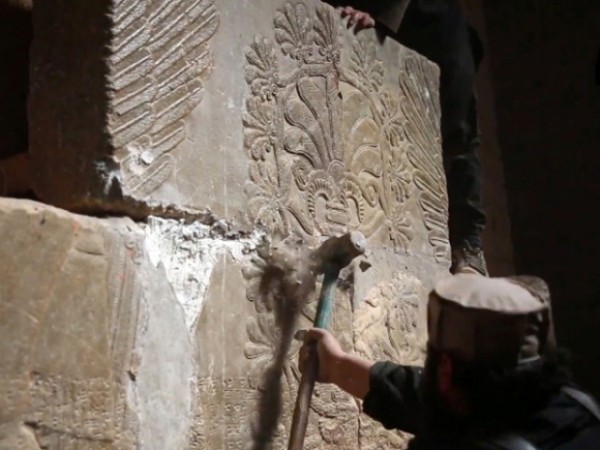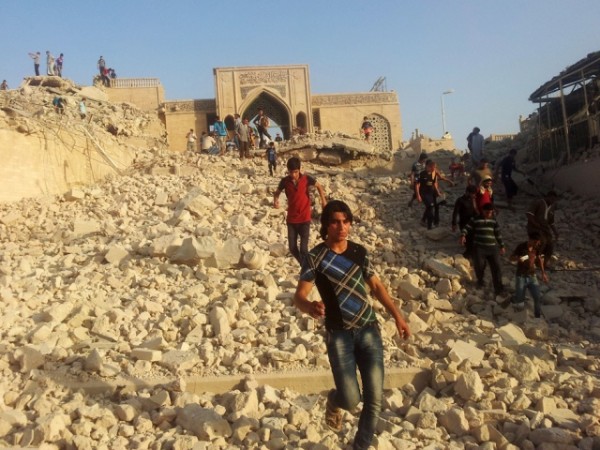
ISIL terrorists have destroyed a number of shrines in Iraq and Syria — including Muslim holy sites — to eliminate what they view as heresy. AFP/Getty Images // The Associated Press VIA social media
ishtartv.com-
nationalpost.com
Joseph Brean |
April 20, 2015 12:51 AM ET
As
ISIL terrorists use power drills, bulldozers and explosives to destroy the
cultural and architectural heritage of ancient Mesopotamia — Christian, Muslim
and pre-Abrahamic from the ancient Assyrian capital Nimrud to the tomb of the
Biblical Jonah in Mosul — western curators hoping to preserve what is left are
caught in a dilemma.
Some
want to buy artifacts to protect and preserve them, such as James Cuno,
president of the J. Paul Getty Trust, the world’s wealthiest art institution,
who has described the vandalism as “an argument for why portable works of art
should be distributed throughout the world and not concentrated in one place.”
But
others are loudly calling for an effective ban on trade in Assyrian antiquities
and other relics from the war zone. They say the Islamic State of Iraq and the
Levant is not simply eradicating the idolatry it denounces as heretical, but in
fact is hypocritically selling what it can on a black market, and destroying
everything else. In this view, buying artifacts to preserve them in Western
galleries is tantamount to funding terrorism.
“If
you’re doing that now with Assyrian artifacts, you’re paying (ISIL),” said
Clemens Reichel, associate curator of near Eastern archaeology at the Royal
Ontario Museum in Toronto, in a lecture this week that labelled the campaign of
destruction “cultural genocide.” It was attended by many ethnic Assyrians,
Chaldeans and Syriacs, including one young man who, with tears in his eyes,
asked in vain for current information on the mosque his grandfather built in
the 1970s, and is buried in, which is now being used as an ISIL command post.
The
targets of the vandalism include Shia shrines, a Christian monastery, and any
relic that ISIL considers idolatrous, including prehistoric statues. Most
destroyed sites are Islamic, which Reichel said is “one of the great
perversities or paradoxes.”
In
Syria, a large majority of artifacts from 34 museums have been secured, Reichel
said. But it is open season on the ISIL-controlled Iraqi parts of ancient
Mesopotamia, famous as the cradle of civilization, between the Tigris and
Euphrates rivers. The archeological heritage here traces back through the
Muslim cultures of recent history to early Christians and the ancient polytheistic
civilizations of Assyria.
The
situation is so dire that western archeologists are even reluctant to express
publicly concern for remaining sites for fear ISIL will take notice and destroy
them too.
“They
literally follow us on Twitter,” Reichel said.
Tombs
are a particular target, such as the tomb of Seth, and the famous Tomb of the
Girl in Mosul, dedicated to a girl who is said to have died of a broken heart.
It was bulldozed last year. Even the tomb of Saddam Hussein, the dictator who
was ousted by the 2003 U.S. invasion of Iraq and then hung by the country he
once ruled, was destroyed last month in his birthplace Tikrit.
The
campaign began in earnest with the fall of Mosul last summer, but recent weeks
have seen the desecration ramp up dramatically. In February, the Mosul Museum
was raided, and images broadcast of men destroying reliefs and statuary from
Nineveh and Nimrud, capitals of ancient Assyria, and statues of kings and gods
from Hatra dating to 300 B.C.
In
March, the archeological sites themselves were targeted. In a video this week,
ISIL men are seen destroying artifacts at Nimrud before a massive explosion
destroyed the site entirely, more than three millennia after it was first
established.
“This
destruction, occurring at an unprecedented scale, represents an irreparable
loss of cultural heritage — not only for Iraq but for all humanity,” the ROM
said in a statement.
News
reports have claimed some destroyed artifacts from museums were “fakes,” but
Reichel pointed out they are in fact restored originals that can be seen in
videos breaking along the seams of repaired cracks.
“What
I find amazing is the level of documentation these videos contain,” Reichel
said. “The level of video documentation is almost commendable at times.”
He
called for prosecution of “cultural genocide” as a war crime. Genocide is a
controversial term, and debates rage about its proper application everywhere
from Turkey to Cambodia to Canada, but it is focused on human deaths. Reichel
said destruction of culture “serves the same purpose.” In ISIL’s case, that
purpose is to create a “tabula rasa,” Latin for blank slate, in which to
establish its caliphate. He denied he was valuing archeology over human life.
“We’re connecting it with the human tragedy,” he said.
Reichel
dedicated his lecture to Donny George Youkhanna, the leading Iraqi archeologist
who was instrumental in protecting and recovering artifacts from the Iraqi
museum after it was looted following the U.S. invasion in 2003. Exiled for his
own safety in 2006, he died of a heart attack in Toronto’s Pearson airport in
2011.
Despite
all this, Reichel said he retains a certain optimism that the present will not
entirely destroy the past. “This is not going to undo the understanding of
ancient Assyria,” he said.

An image grab taken from a video made available by Jihadist media outlet Welayat Nineveh on April 11, 2015, allegedly shows members of ISIL destroying a stone slab with a sledgehammer at what they said was the ancient Assyrian city of Nimrud in northern Iraq. AFP/Getty Images

In this Thursday, July 24, 2014 file photo, people walk on the rubble of the destroyed Mosque of The Prophet Yunis, or Jonah, in Mosul, 360 kilometres northwest of Baghdad, Iraq. AP Photo, File
|